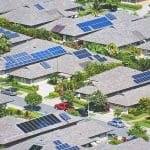Choosing the best angle and direction for your solar panels will optimize the amount of sunlight they receive and allow you to get the most out of your solar power system. Some who install them on their roofs are somewhat limited, but if you have the luxury of choosing exactly how you want your system setup, there are a few tricks you can use to determine how you should tilt and point your panels. We are going to go over some calculations, but fret not! If you can perform some basic arithmetic, you’ll have no problem. In the worst case scenario, just grab a calculator and punch in the numbers. But, before we get to any calculations, let’s look at how you can find the best direction to point your solar panels in.
Finding the Best Direction
Locating the best direction to point your solar panels can be accomplished very quickly. You could use tools if you wanted to, but you can just as quickly figure it out with none at all. The rule is that if you live in the southern hemisphere, you should point your panels true north, and if you live in the northern hemisphere, you should point them true south. Now, a compass tells you magnetic north and south, but it does not show you true north and south. There is a difference. A compass works using the magnetism of the north and south poles, whereas true north and south can be found based on geography. So, don’t grab a compass expecting to find the best direction with it. If this is a little over your head, let’s just go ahead and look at the simple way to find true north and south.
If you live in the northern hemisphere, at noon, shadows from vertical objects will face true south. Simply go outside and look at where your shadow faces. You could even stick a stick in the ground and take note; this is the direction your solar panels should face.
On the other hand, if you live in the southern hemisphere, you can use this same technique; however, you would want to face your solar panels in the opposite direction of where your shadows face. This is a simple tried and true way to find the perfect direction, and like I said, you can do it with no tools.
If that doesn’t work for you, you can center your home on Google Earth and look at the grid the application it provides; this will show you true north and south. If these techniques don’t work for you, keep in mind that magnetic north and south is pretty close to true north and south. You could use a compass to find the direction and still get pretty good results although not perfect.
Finding the Best Angle
Mathematics comes into play when you need to find the angle of your solar panels. Before you can do the math, however, you will need to know your latitude. Using Google Maps or any of the many tools online, you can easily find your latitude. Once you have figured this out, you can use one of the formulas below to calculate the best angle for your solar panels for each season.
- Spring / Fall: latitude – 2.5 degrees
- Summer: (latitude x 0.9) – 23.5 degrees
- Winter: (latitude x 0.9) – 29 degrees
The answers you end up with are the best angles for each particular season.
As you can see, configuring the direction and angle for solar panels is not too complicated; it only takes a few minutes. One last point to consider is that each person’s conditions are different, and you may have to make minor adjustments to your setup. For example, if trees or other object block the sun from shining on your panels, you may have to change your approach to achieve the best results. For this reason, it’s a good idea to map out the best area to place your panels before you even begin the installation process. The more prepared you are, the happier you will be with the power you gain from earth’s free energy source.





